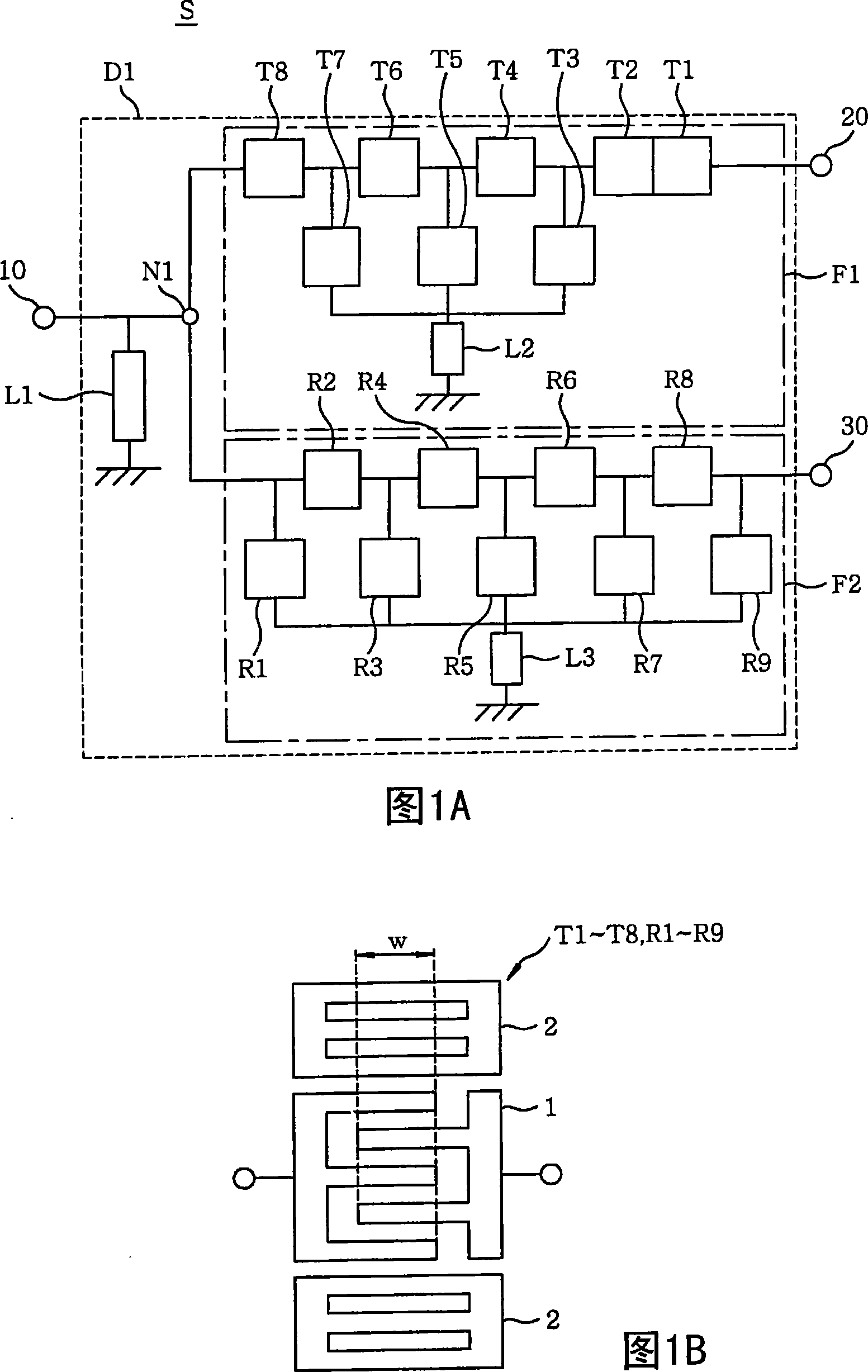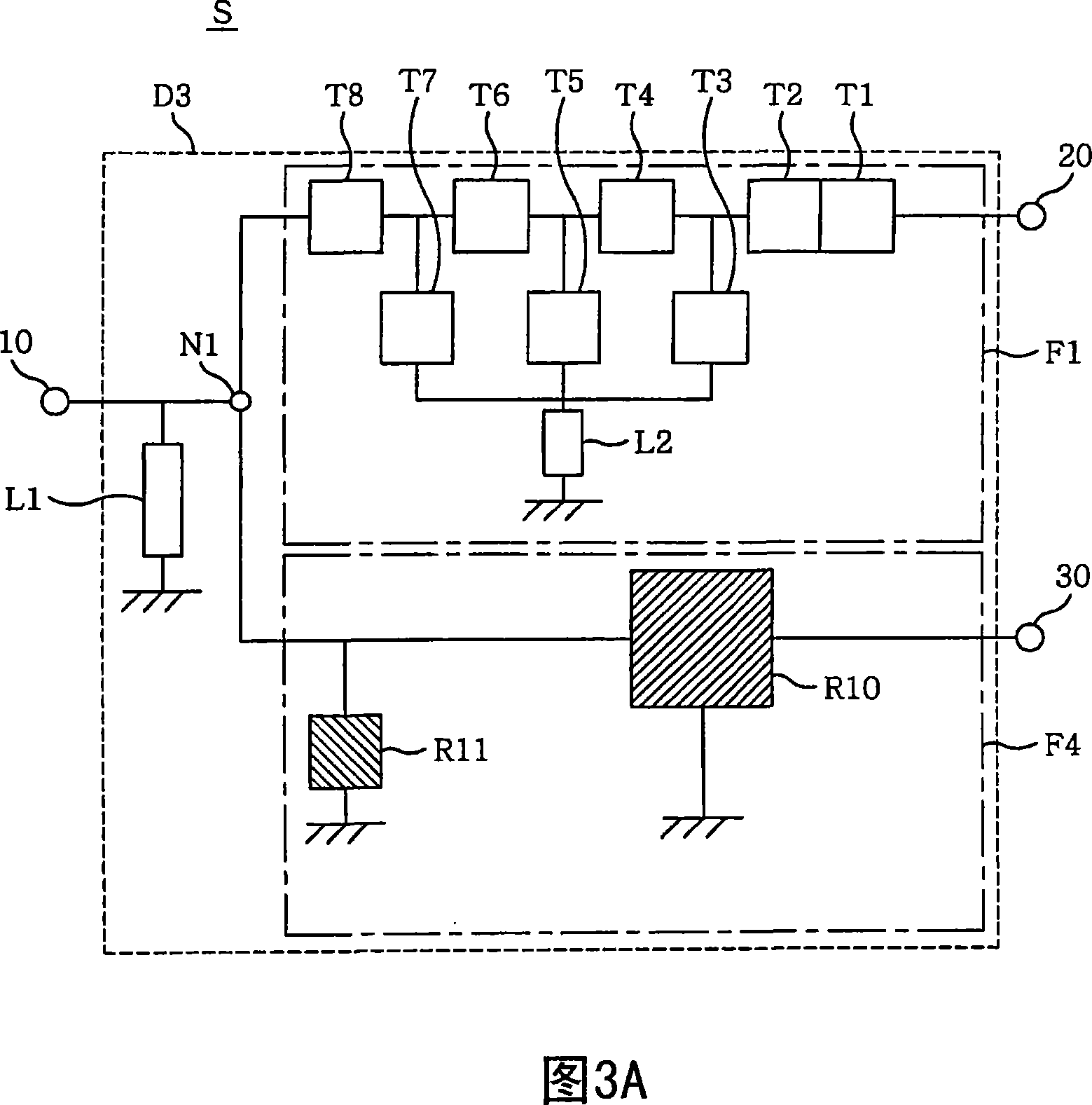Duplexer and communications equipment
A duplexer and passband technology, applied in the field of duplexers, can solve the problems of deterioration of attenuation characteristics, deterioration of transmission signal attenuation characteristics, etc.
- Summary
- Abstract
- Description
- Claims
- Application Information
AI Technical Summary
Problems solved by technology
Method used
Image
Examples
no. 1 example
[0032] (The principle structure of the duplexer)
[0033] 1A and 1B are used to explain the duplexer D1 in the first embodiment of the present invention. More specifically, FIG. 1A is a circuit diagram of a duplexer D1, and FIG. 1B is a top view illustrating a representative structure of a resonator from which the duplexer D1 is formed. The structure of the duplexer D1 is such that a transmission filter F1 connected to the transmission terminal 20 and a reception filter F2 connected to the reception terminal 30 are connected to the antenna terminal 10 through a common signal line. The node N1 connects the transmit side end of the transmit filter F1 and the receive side first part of the receive filter F2. The node N1 is also connected to the antenna terminal 10 . In FIG. 1A , the dashed line indicates the area of the duplexer D1, and the dashed-dotted line indicates the areas of the transmit filter F1 and the receive filter F2, respectively. However, these lines do not ac...
no. 2 example
[0067] FIG. 2 is a circuit diagram of a duplexer D2 in a second embodiment of the present invention. The duplexer D2 is configured such that the transmit filter F3 connected to the transmit terminal 20 and the receive filter F2 connected to the receive terminal 30 are connected to the antenna terminal 10 through a common signal line.
[0068] The signal transmission and reception of the duplexer D2 is performed in the same manner as the signal transmission and reception of the duplexer D1 in the first embodiment. That is, the signal (reception signal) received by the antenna terminal 10 is sent to a receiver circuit (not shown) through the reception filter F2 and the reception terminal 30 . Further, a signal (transmission signal) input to the transmission terminal 20 from a transmitter circuit (not shown) is transmitted to the antenna terminal 10 through the transmission terminal F3.
[0069] Furthermore, also in this embodiment, the duplexer D2 is configured such that the pa...
no. 3 example
[0079] In the first and second embodiments, the transmission filter and the reception filter are formed using ladder filters. However, the structure of the duplexer in the present invention is not limited to this. 3A and 3B are used to explain the duplexer D3 in the third embodiment of the present invention. Specifically, FIG. 3A is a circuit diagram of the duplexer D3, and FIG. 3B is a schematic top view of a representative structure of a DMS (Dual Mode SAW) filter R10 included in the duplexer D3. The duplexer D3 is configured such that the transmit filter F1 connected to the transmit terminal 20 and the receive filter F4 connected to the receive terminal 30 are connected to the antenna terminal 10 through a common signal line.
[0080] Transmission and reception of signals in the duplexer D3 are performed in the same manner as in the duplexer D1 in the first embodiment. That is, a signal (reception signal) received by the antenna terminal 10 is sent to a receiver circuit (...
PUM
 Login to View More
Login to View More Abstract
Description
Claims
Application Information
 Login to View More
Login to View More - R&D
- Intellectual Property
- Life Sciences
- Materials
- Tech Scout
- Unparalleled Data Quality
- Higher Quality Content
- 60% Fewer Hallucinations
Browse by: Latest US Patents, China's latest patents, Technical Efficacy Thesaurus, Application Domain, Technology Topic, Popular Technical Reports.
© 2025 PatSnap. All rights reserved.Legal|Privacy policy|Modern Slavery Act Transparency Statement|Sitemap|About US| Contact US: help@patsnap.com



